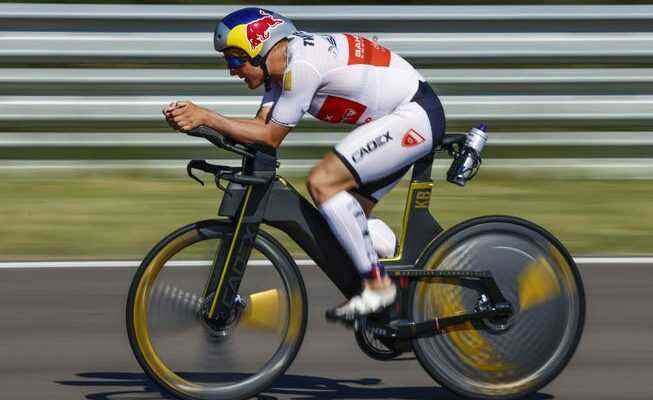The 28-year-old Norwegian is a phenomenon in his sport. At the Lausitzring, he improved the Ironman best time by over half an hour. And his appetite is still not satisfied.
Kristian Blummenfelt on his futuristic bike without a top tube: At the Lausitzring he covers the 180 km bike course within an Ironman in 3:24:22 hours, which corresponds to 53 km/h.
Of course, Kristian Blummenfelt also managed to be the first person to complete the Ironman distance in less than seven hours. On Sunday he undercut the mark by a good quarter of an hour. 6:44:26 hours for a 3.8 km swim, 180 km bike ride and 42 km run. For the final marathon he needed 2:30 hours, no one has ever run that fast in an Ironman.
The Sub7 project at the Lausitzring in eastern Germany was a race under laboratory conditions. Helpers were allowed in all disciplines, the courses were flat and there were no regulations when it came to equipment. This makes it easier to improve a record, for example that of 7:21:12 hours, set at a regular Ironman – by Blummenfelt himself.
At the press conference ahead of Sunday’s venture, he said: “I feel a little unbeatable… And he smiled gently at that, not the least bit embarrassed.
Blummenfelt is bulky, very muscular
In fact, the 28-year-old Norwegian has always won, or more precisely: since last summer’s Olympic Games. After winning the Olympics, he became world champion over the short distance and tried his first Ironman in November – he completed it in record time. His second Ironman was the World Championships, moved from Hawaii to Utah, in May. A win there too. And now that record at the Lausitzring, a good three minutes ahead of his competitor Joe Skipper.
@kristianblu for the #sub7 win! Congratulations!
??♂️48:21
?♂️ 3:24:22
?♂️2:30:50
Sub 7 – 6:44:25#sub7sub8 @pho3nixlife pic.twitter.com/6yIVMNvFMo— Bahrain Endurance 13 (@bahraintri13) June 5, 2022
This superiority over the short and long distances makes Blummenfelt unique in triathlon. Although there is the Olympic champion Jan Frodeno, who also became the Ironman dominator, there were years in between. And there are also those short-distance specialists who shine over half the Ironman distance and then try it over the whole distance – but that takes time and rarely ends in success.
Blummenfelt is not a triathlete as it is written in the book anyway. He is beefy, very muscular; one wonders that he can still walk as stylishly as all the other delicate athletes. So it’s kind of fitting that he also manages to be successful at both long and short ranges.
His coach Arild Tveiten has known Blummenfelt for over ten years. He says Kristian isn’t super talented, but he has a strong heart and big lungs. And the fact that he was a gifted swimmer in his youth helps him too. But the key to his recent success lies in the fact that ten years ago, Tveiten became sporting director of the Norwegian Triathlon Association and set himself the ambitious goal of forming the world’s best national team in his sport.
The course of the hem on the racing suit is optimized in the wind tunnel
Blummenfelt says about his coach in a YouTube documentary from 2020: “Most of the time, the coach has to slow down his athletes in their zeal. But here it’s the other way around: sometimes I have to slow down the coach because he’s so motivated.” This attitude was boosted when sports scientist Olav Aleksander Bu joined the Norwegian team in 2016. He is known for getting up at five o’clock every morning and first combing through the science portals for new findings that could advance the sport of triathlon.
Kristian Blummenfelt: “Sometimes I have to slow down the coach because he is so motivated.”
Meanwhile, the Norwegian triathlon squad is being measured completely, every milliliter of oxygen is recorded, every calorie consumed. Questions will also be answered such as: Does the energy consumed come from carbohydrates or from fat? It goes without saying that even the smallest change in seating position is tested in the wind tunnel. At Blummenfelt, meticulousness is taken to the extreme; even the course of the hem on his racing suit is optimized in the wind tunnel.
The result of these efforts was spectacular for the first time in 2018: In the World Championship series race in Bermuda, three Norwegians were on the podium, never before has there been such a dominance in men’s triathlon. Casper Stornes won in front of Blummenfelt and Gustav Iden. These three athletes have been training together for more than ten years and still push themselves to achieve top performance, even outside of training. “If I see that Casper and Gustav go to bed earlier, I do that too,” says Blummenfelt.
His training volume amounts to an unbelievable 1300 hours per year; That’s around 300 hours more than the top cross-country skiers, and they’re not known to be lazy about training. Coach Tveiten says soberly: “Kristian needs a lot of training.”
He imagines being pursued by a dangerous animal
For Blummenfelt, all the hard units at home or in training camps in lonely places mean no sacrifice. He was able to turn his hobby into a job, “why should training be a sacrifice?”. He can also put the pain when the muscles are just burning into perspective without any problems: “I don’t love the pain, but I love losing a race even less.” What drives him is fear, he says. When the competition reaches its decisive phase, he imagines himself being pursued by a dangerous animal. That pours out enough adrenaline.
And what happens now that he has already achieved everything? “I want to win everything this year,” says Blummenfelt. The next meeting point is the Ironman World Championships in Hawaii in October; hard to imagine who should get in the way of this Norwegian there.
